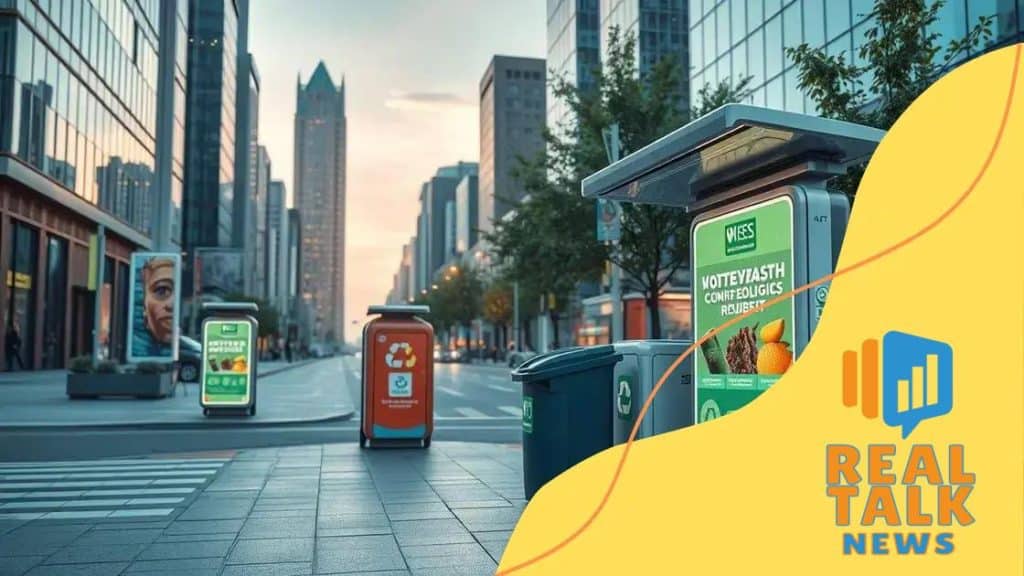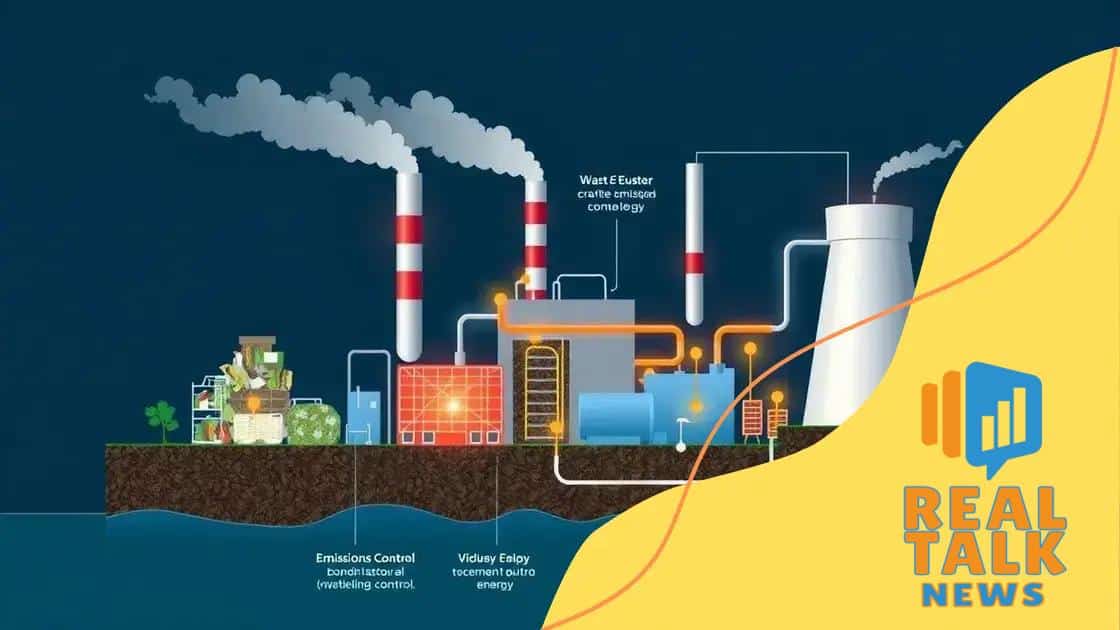Innovations in waste management technology for urban areas

Community engagement in waste management is crucial for enhancing recycling rates and reducing waste, involving residents through education, incentives, and active participation in local initiatives.
Innovations in waste management technology for urban areas are reshaping how cities tackle waste. Have you noticed how some cities are turning trash into treasure? This article takes you through the latest breakthroughs that promise to enhance urban living and sustainability.
Smart waste collection systems
Smart waste collection systems are revolutionizing how cities manage their waste. These innovative approaches utilize technology to improve efficiency and sustainability in urban environments. Cities around the world are adopting these systems to make waste management easier and more effective.
The Benefits of Smart Waste Collection
Implementing smart waste collection offers several advantages that can enhance urban life. These include:
- Increased efficiency: Sensors in waste bins can alert collection services when they are full, optimizing collection routes.
- Cost savings: Reducing unnecessary pickups can lower operational costs for waste management.
- Environmental impact: Efficient collection reduces the carbon footprint associated with garbage trucks.
- Data-driven decisions: Analyzing waste data helps cities plan better and allocate resources wisely.
In addition to these benefits, smart waste collection systems promote community involvement. By providing residents with real-time information about their waste disposal habits, cities can encourage better recycling practices. People can track their waste generation and find out how to reduce it effectively.
Technology Behind Smart Systems
Various technologies are integral to smart waste management. For instance, IoT (Internet of Things) devices equipped with sensors are placed in waste bins. These devices monitor fill levels and notify collection services when it’s time to empty them. Furthermore, mobile apps allow residents to report issues like overflowing bins or missed pickups, keeping communities engaged and accountable.
With the growth of smart waste systems, cities can analyze data collected from these sensors to predict waste generation trends. This predictive analysis can guide future infrastructure investments, ensuring that cities stay ahead of the curve.
As we look ahead, the integration of artificial intelligence and machine learning into these systems will further enhance their capabilities. For example, AI can help optimize routes for waste collection trucks in real time, taking traffic patterns and weather conditions into account.
In conclusion, smart waste collection systems not only streamline operations but also foster a culture of sustainability within urban areas. By embracing these innovations, cities take significant steps toward cleaner and greener environments.
Recycling technology advancements
Recycling technology advancements are critical for improving how we manage waste. By enhancing recycling processes, we can reduce landfill use and promote sustainable practices. Cities are investing in new technologies that make recycling more efficient and effective.
New Innovations in Recycling
Recent developments in recycling technology are making it easier for communities to recycle. These include:
- Automated sorting systems: Machines now use AI to identify and sort different materials, increasing recovery rates.
- Advanced recycling methods: Technologies like chemical recycling can process plastics that traditional methods cannot.
- Mobile recycling units: These portable systems allow for on-site recycling in areas lacking facilities.
- Consumer engagement apps: Applications that educate users about recycling and track their progress.
The introduction of automated sorting systems has significantly stepped up the efficiency of recycling facilities. With the help of sensors and cameras, these systems can quickly separate materials like glass, paper, and plastics. This innovation leads to a higher rate of material recovery. Plastic waste, in particular, has seen advances through methods like chemical recycling, which breaks plastics down into their basic components for reuse, offering a solution to the long-standing issues of plastic waste.
Community Impact and Education
As technology improves, community engagement becomes equally important. Education plays a pivotal role in ensuring that people understand how to recycle correctly. With the introduction of consumer engagement apps, residents can learn best practices and keep track of their recycling habits.
These apps not only promote recycling but also encourage communities to participate in local programs. Real-time feedback and gamification elements make recycling more engaging, inspiring people to take action. This combined approach—leveraging advanced technology while fostering community involvement—creates a culture of sustainability.
Furthermore, advancements in recycling technology are impacting industries beyond waste management. For example, new materials can be created from recycled products, closing the loop in manufacturing. Innovations help reduce reliance on virgin resources, making a strong case for sustainable practices.
Waste-to-energy solutions

Waste-to-energy solutions are becoming a key part of modern waste management strategies. By converting waste into energy, cities can reduce landfill use and generate power, making this approach both sustainable and efficient.
How Waste-to-Energy Works
The process involves several steps to transform waste into usable energy. This typically includes:
- Collection and sorting: Waste is gathered and sorted to remove recyclable materials.
- Incineration or gasification: The remaining waste is burned or heated, releasing energy.
- Energy recovery: The energy produced can be converted into electricity or heat.
By using technologies like incineration and gasification, waste-to-energy plants significantly reduce the volume of waste while producing valuable energy. This dual benefit makes the approach attractive to urban planners and environmentalists alike.
Environmental Benefits of Waste-to-Energy
One of the main advantages of waste-to-energy solutions is their positive impact on the environment. By diverting waste from landfills, these solutions help decrease greenhouse gas emissions. Landfills are significant sources of methane, a potent greenhouse gas, and by minimizing waste in these sites, cities can lower their carbon footprint.
Moreover, waste-to-energy facilities can also produce renewable energy, contributing to a more sustainable energy mix. This renewable energy can help power homes and industries, reducing reliance on fossil fuels. As cities embrace waste-to-energy, they are taking significant steps towards a greener future.
Community involvement is also crucial for the success of waste-to-energy solutions. Educating residents about waste sorting can maximize the efficiency of energy recovery. When individuals understand the importance of reducing waste and participating in sorting efforts, they contribute to a more effective waste management system.
In summary, waste-to-energy solutions represent a forward-thinking approach to urban waste management, combining sustainability with energy production. Cities that implement these solutions can benefit economically, environmentally, and socially.
Biodegradable materials in urban areas
Biodegradable materials in urban areas play a crucial role in reducing waste and promoting sustainability. These materials break down naturally, minimizing environmental impact and easing the strain on landfills. As cities strive for greener solutions, the use of biodegradable products is becoming increasingly important.
Types of Biodegradable Materials
Biodegradable materials come in various forms and can be used in many everyday items. Common examples include:
- Food waste: Organic waste from kitchens can compost easily, enriching soil.
- Bioplastics: Made from renewable biomass sources, bioplastics are designed to decompose.
- Paper products: Most paper items break down quickly unless treated with chemicals.
- Textiles: Clothing made from natural fibers like cotton or wool will also biodegrade.
These materials not only help in waste reduction but also provide a more sustainable alternative to traditional plastics, which can take hundreds of years to decompose.
The Benefits of Using Biodegradable Materials
Adopting biodegradable materials in urban areas leads to multiple benefits. For one, it helps decrease the volume of waste sent to landfills. This reduction is essential for managing municipal waste effectively. Additionally, when biodegradable materials break down, they can enhance soil quality by returning nutrients to the earth.
Moreover, shifting towards biodegradable products can significantly lessen pollution. Unlike conventional plastics that can cause harm to wildlife and ecosystems, biodegradable options can break down in natural environments, posing less risk to wildlife.
Public awareness is crucial for increasing the use of biodegradable materials. Educating residents on proper disposal methods ensures that these materials are treated correctly, allowing them to break down as intended. Many urban areas have also begun initiatives to encourage the use of these materials, promoting composting and providing resources to assist residents.
Community engagement in waste management
Community engagement in waste management is essential for creating effective and sustainable practices. When residents are involved in the management of their waste, the results can lead to significant improvements in recycling rates and waste reduction. Engaging the community encourages people to take responsibility for their waste and fosters a culture of sustainability.
Ways to Foster Community Engagement
There are several strategies that cities can use to boost community involvement in waste management. These include:
- Education programs: Workshops and seminars can inform residents about proper waste disposal and recycling.
- Volunteer clean-up events: Organizing local clean-ups encourages residents to actively participate in keeping their neighborhoods clean.
- Incentive programs: Awards or recognition for neighborhoods that excel in waste reduction can motivate residents.
- Feedback mechanisms: Providing platforms for residents to voice concerns or suggestions helps them feel heard and valued.
These initiatives not only create awareness but also build a sense of community among residents. Participating in waste management efforts can lead to stronger neighborhood bonds as people work together toward common goals.
Successful Community Initiatives
Many cities are already seeing the benefits of community engagement in waste management. For example, recycling competitions have been organized, where neighborhoods compete to achieve the highest recycling percentages. This not only generates excitement but also leads to measurable results in waste diversion.
Another successful initiative involves partnering with local schools. Educational programs tailored for students can instill good habits early on. Students often take their knowledge home, influencing their families and communities.
Furthermore, social media campaigns can effectively spread awareness and encourage involvement. By sharing stories, tips, and challenges, cities can engage their citizens in conversations about waste management. These discussions often lead to greater participation in local initiatives and increased commitment to sustainable practices.
Ultimately, community engagement is a vital piece of the waste management puzzle. When people are aware and involved, they tend to make better choices regarding waste disposal and recycling, leading to healthier, greener urban environments.
FAQ – Frequently Asked Questions about Community Engagement in Waste Management
Why is community engagement important for waste management?
Community engagement helps raise awareness and responsibility among residents, leading to better recycling practices and waste reduction.
How can I get involved in local waste management efforts?
You can participate in community clean-up events, attend educational workshops, or join local recycling competitions.
What benefits do incentive programs provide?
Incentive programs motivate residents to participate more actively in waste management, often leading to improved recycling rates in neighborhoods.
How can technology help in community engagement?
Technology, such as social media and mobile apps, can be used to share information, promote initiatives, and encourage residents to engage in waste reduction efforts.





